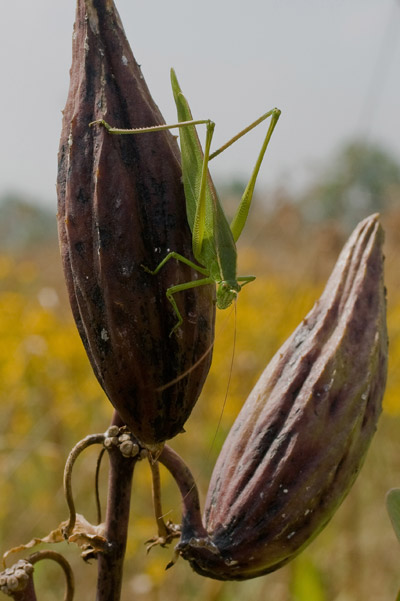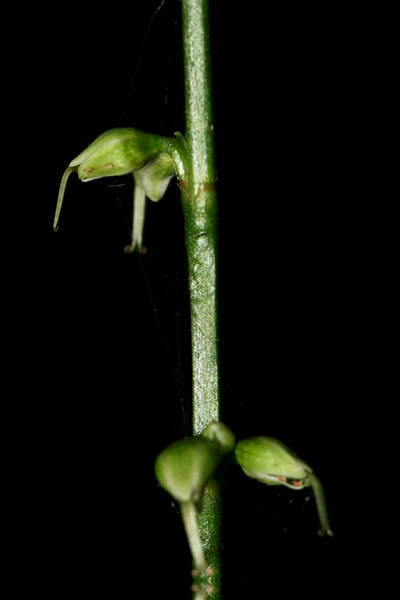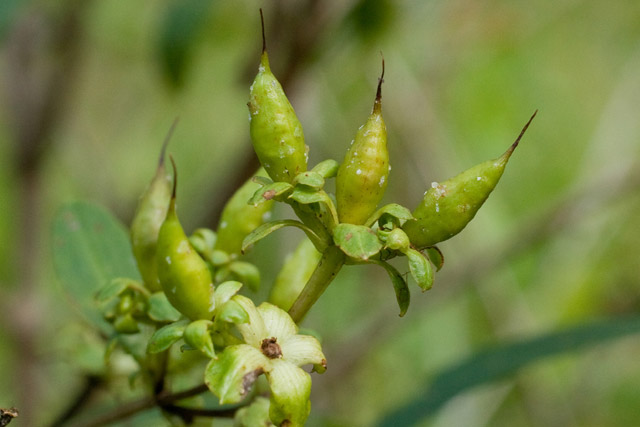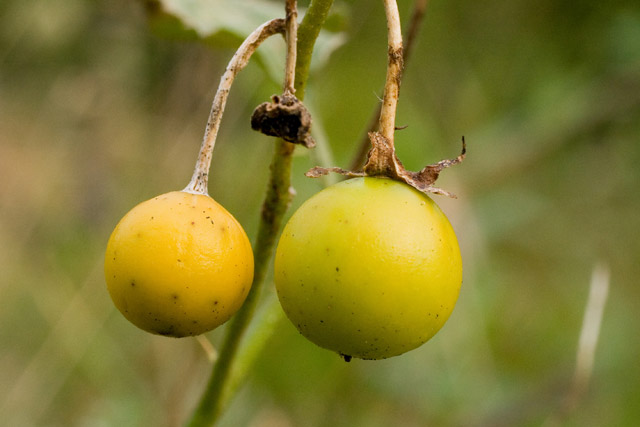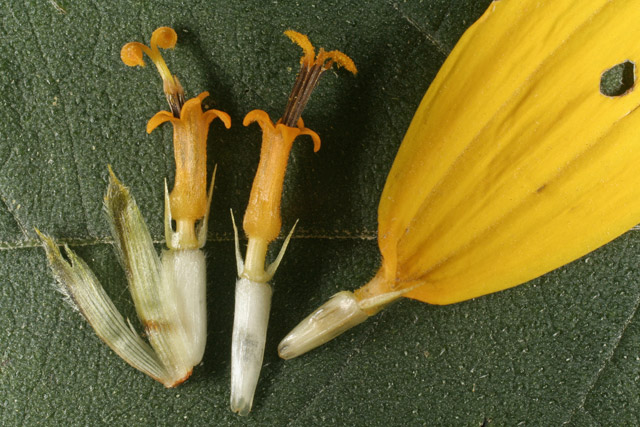 |
 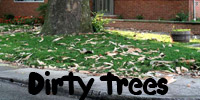  |
Welcome
to bobklips.com, the website of Bob Klips, a plant enthusiast living in
Columbus, Ohio. Hedge (Osage-orange, Maclura pomifera) Delaware, Ohio. September 26, 2008 Osage-orange (Maclura
pomifera,
family Moraceae) is a medium-sized tree that is distinctive now because
of its softball-sized multiple fruits that adorn the branches and then
fall to the ground. The Moraceae is the mulberry family and, like
mulberries, the huge Osage-oranges are actually clusters of many small
fruits tightly packed together, derived from a head-like
cluster
of small individual flowers.
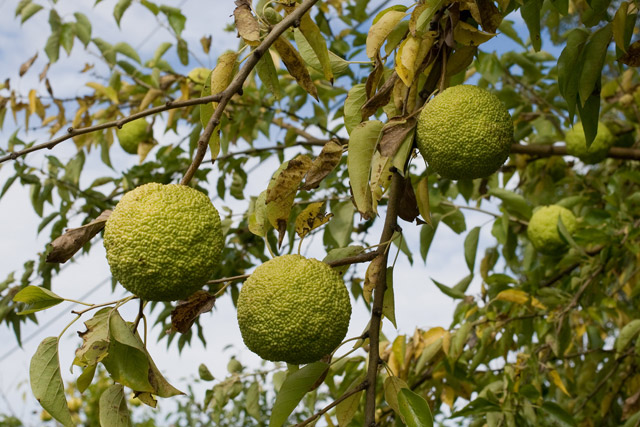 Osage-orange along road in Delaware, Ohio, September 26, 2008. Osage-oranges have been
the subject of
some speculation with respect to their palatibility to wildlife. Fleshy
edible fruits are an adaptation that serves to disperse
their seeds. There are few instances of wild animals eating
Osage-oranges, at least around here, and they seem to just sit on the
ground wondering why nobody likes them, and
eventually decay.
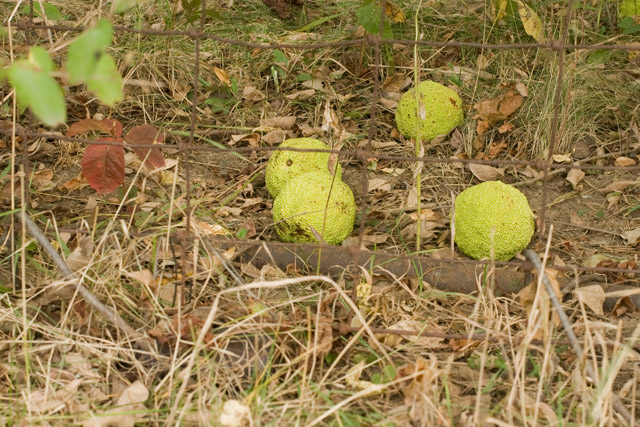 Osage-oranges on the ground, Delaware, Ohio, September 26, 2008. The apparent lack of
animal dispersers has lead some people to suggest that Maclura
pomiferais
an "anachronistic plant," i.e., one having an
evolutionarily co-adaptive connection with one or
more
animals that are now extinct. As recently as
10,000 years ago, there were numerous large animals ("megafauna"), such
as mastodons, mammoths, horses, and many others that are no longer with
us. Perhaps they liked these big green mulberries. On the other hand
there are a few observations in the remarkably small home range of the
species --tiny portions of Texas, Oklahoma and Arkansas (home
of the Osage Indians) --of squirrels eating them, and horses
avoiding them.
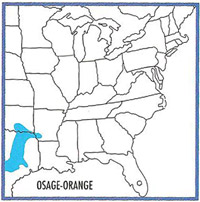 Osage-orange range map. (Peterson Eastern Trees Field Guide) While the natural range
of Osage-orange is
quite small, it is widepread in the midwest because it was once widely
planted as a living fence. Another common name is "hedge."
Osage-orange hedgerows have the
properties of barbed wire owing to its sharp stout thorns.
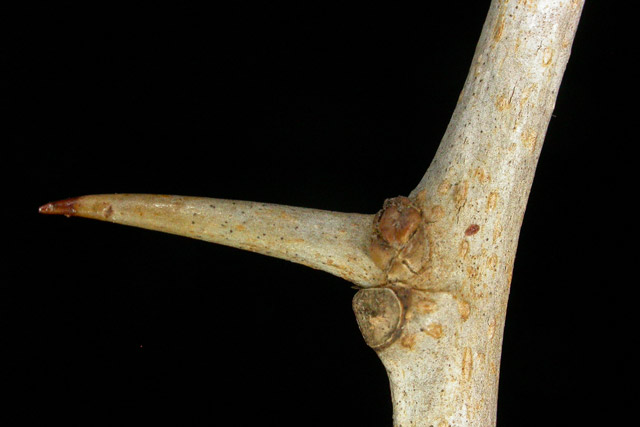 Osage-orange twig, showing a stout sharp thorn. The Fruits of Fall September, 2008 A
flower's ovary is the lowermost portion of its pistil (also
called the gynoecium), the female part of the flower. The ovary
contains one or more ovules, within each of which there is an egg.
After a pollen grain delivers a sperm cell to fuse with the egg, a new
embryo (baby plant) develops within the ovule, which eventually becomes
a seed. A fruit is a ripened ovary
containing seeds.
This month, many plants are in fruit that were more conspicuous earlier, when they were in flower. They are still beautiful and intriguing while in fruit, but they are certainly less attractive, because the portion of the flowers that served to advertise their presence to pollinating insects --the petals --have long since fallen off. Here are several fruits of September, along with pictures (MOUSEOVER to see) showing what they looked like earlier in the season. (The flower pics may have been taken at a different location.) 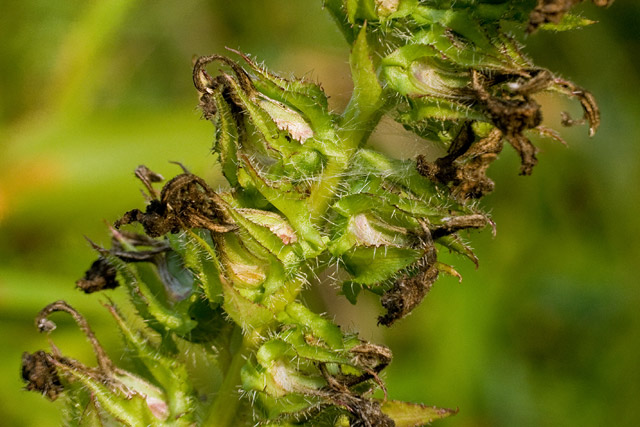 Great lobelia (Lobelia syphilitica) fruits. Deep Woods Preserve, Hocking County, OH. September 17, 2008. Sullivant's
milkweed (Asclepias sullivantii) fruits.
Killdeer Plains Wildlife Area, Marion County, Ohio, September 2, 2008. Jumpseed
(Tovara virginiana) fruits.
Nashville, Miami County, Ohio, September 20, 2008. Horseweed
(Solanum caroliniense) fruits.
Deep Woods Preserve, Hocking County, OH. September 17, 2008 The
Asters
of Autumn
September 19-20, 2008 Hocking County and Miami County, Ohio. The plant family Asteraceae (aster family) also has a traditional, more descriptive name: the "composite" family. This is because what looks like one big showy flower is actually a tightly packed cluster --a composite --of many small individual blooms. These flowers are sometimes of 2 different types: (1) centrally located, radially symmetric disk flowers, and (2) peripheral strap-shaped ray flowers. In the picture below, the honeybee is gathering nectar from the disk flowers while the spotted cucumber beetle is standing on a ray flower. 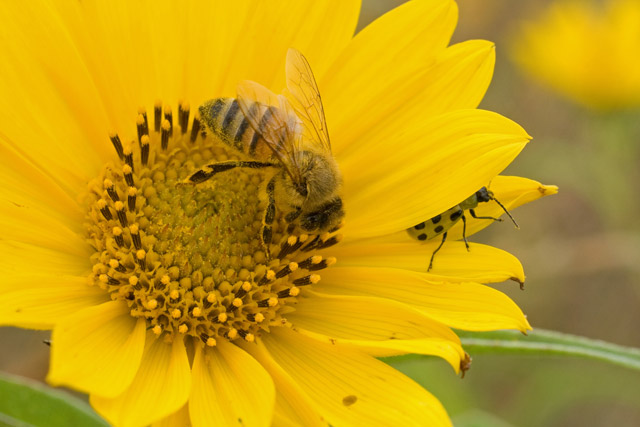 Flower head of a sunflower, Helianthus maximilianii. September 20, 2008, Tipp City, Miami County, Ohio. Below, a picture taken in 2007 shows individual flowers teased from a sunflower head to demonstrate the two types of flowers and show the individual parts (in some instances highly modified) that comprise a flower. Unless they are the only type present, the strap-shaped RAY FLOWERS are usually sterile, serving solely to attract pollinators as do the individual petals of a single flower, which they indeed resemble. The central DISK FLOWERS have their OVARY way down at the bottom of the flower (this is an "inferior ovary"). The ovary is the part that eventually develops into a dry one-seeded fruit --an achene --that is often colloquially referred to as a "seed." (A "sunflower seed" is a actually a fruit that you split open to eat the seed inside.) Just above the ovary are the SEPALS, so highly modified they have a special name: the PAPPUS. In the sunflower the pappus is a simple pair of scale-like bristles, but in other members of the Asteraceae such as the dandelion, the pappus is an eleborate parachute-like organ that aids in fruit dispersal. The corolla consists of 5 fused PETALS from which protrude the uppermost sexual parts of the flower: (1) the pollen-producing STAMENS which are fused into a tube through which grows the STYLE which is capped by rabbit-ear-like STIGMAS that receive pollen. Interestingly, the stamens split open and release theirn pollen towards the inside of the stamen-tube and so the pollen is presented on the non-receptive backsides of the stigmas. It looks like self-pollination, but it isn't. These flower parts are labelled in the alternate (mouseover) view of the picture below. MOUSEOVER the IMAGE to see parts labelled.
Flowers of Jerusalem artichoke (Helianthus tuberosus). The Asteraceae is the largest plant family in our region. It is not economically important; sunflower seeds, lettuce, artichokes, and safflower for oil are pretty much the only foods we get from the family. But aster family members are ecologically important. This family predominates, along with grasses and legumes, in prairies and meadows. It is especially conspicuous in late summer and autumn, when many of them are in flower, sometimes profusely. The most conspicuous members of the Asteraceae in our region at this time of the year are goldenrods (genus Solidago). These showy guys often get unfairly blamed for allergies actually brought on by ragweeds flowering at the same time as the goldenrods but which, being wind-pollinated, lack showy parts and so aren't noticed. Here are are two goldenrod species common in fields.  Canada goldenrod (Solidago canadensis). September 19, 2008, Deep Woods Preserve, Hocking County, Ohio. 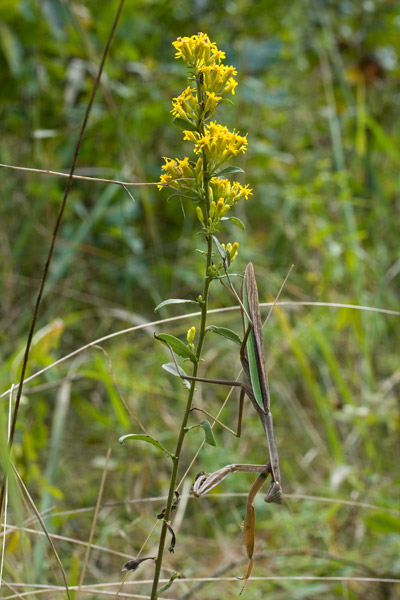 Gray goldenrod (Solidago nemoralis). September 19, 2008, Deep Woods Preserve, Hocking County, Ohio. Vittaria appalachiana (family Vittariaceae) Deep Woods Preserve, Hocking County, Ohio September 19, 2008 Introduction: the typical fern life cycle. (Christmas fern example) The
plant life cycle is
more intricate
than the animal life cycle. It is an "alternation of generations" life
cycle in which one type of plant --the sporophyte stage of the life
cycle-- produces and releases spores. A spore is a cell
that develops independently into a new multicellular plant.
The
plant that develops from a spore is a very different than the
plant that
produced the spore. The spore develops into the
gametophyte
stage of the life cycle. A gametophyte is a plant that produces
gamete, i.e., eggs and sperm. Gametes (eggs and sperm) are cells that
must fuse together to advance the life cycle. When an egg is
fertilized by a sperm, the embryo that results develops into a
new
sporophyte. Thus, the plant life cycle alternates between a
spore-producing sporophyte and a gamete-producing gametophyte.
Here's a rough sketch of the fern life cycle, showing a big leafy sporophyte producing spores that develop into the miniscule inconspicuous gametophyte, which produces the gametes that give rise to big leafy sporophytes, and so on....(it's a cycle):  Sketch of fern life cycle. In the fern life cycle, the conspicuous and ecologically important stage of the life cycle that you would normally refer to as the "fern," is the sporophyte. Here's an example of a a typical fern sporophyte: Polystichum acrostichoides (Christmas fern). 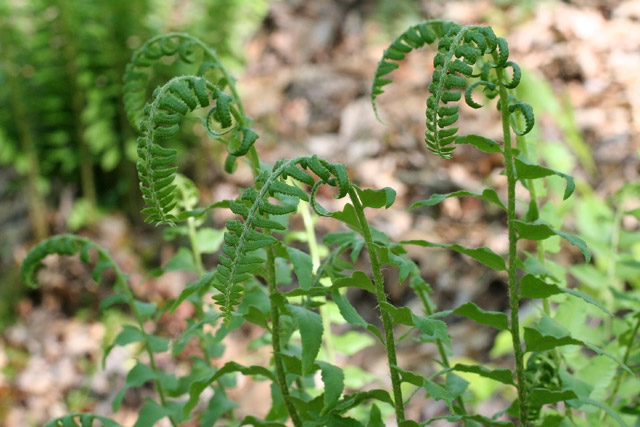 Christmas fern showing fertile (spore-producing) leaflets at upper portion of plant. May 7, 2006, Deep Woods Preserve, Hocking County, Ohio. As
is often the case,
Christmas fern
spores are borne in pinhead-sized sporangia (spore cases) that
are
aggregated into readily visible clusters called "sori." On many ferns,
the sori are located on the leaf undersurface. In
the photo below, the very numerous tiny granular-looking sprorangia are
partly covered
by protective circular flaps of leaf tissue called "indusia."
Approximately 50 sori (each consisting of an indusium plus its
associated sporangia) are shown.
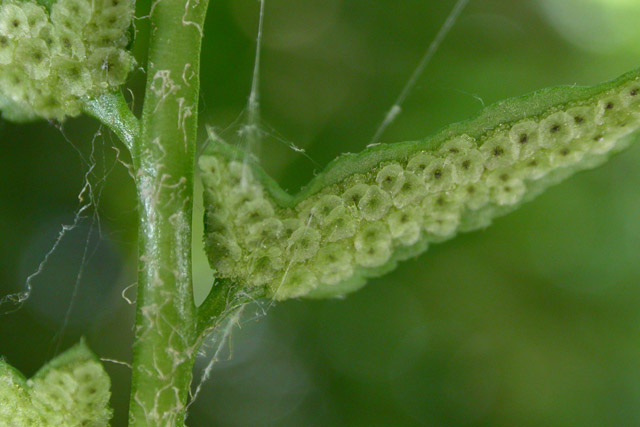 Christmas fern sori, May 29, 2005, Deep Woods Preserve, Hocking County, Ohio. When
the spores are
mature, the sporangia
rupture and the freed spores are flung away from the parent plant.
A lucky spore that lands somewhere moist and otherwise suitable
for
germination develops into a little fingernail-sized, flat,
indistinctive, vaguelly heart-shaped gametophyte. (A fern
gametophyte is sometimes called a "prothallus" because it is an
undifferentiated plant, i.e., a thallus,
that proceeds
the fern.) Embedded in the prothallus are separate vessel-like
structures that
produce sperm, and eggs. Fern sperm travel from one
gametophyte to another, where an egg awaits, through environmental
water. This is one reason why many ferns are restricted to moist
places.
After fertilization, the developing embryo sporophyte stays briefly attached and nutritionally dependent on the maternal gametophyte. Eventually the new fern sporpphyte is large enough to persist on its own, and then the tiny used-up gametophyte withers away. Here's a picture showing baby Christmas fern sporophytes still attached to the maternal gametophytes that produced them.  Flat undifferentiated Christmas fern gametophyte (prothallus) with leafy young sporophyte attached. October 22, 2007, Chimney Rocks, Pike County, Ohio. But the Applachian gametophyte is atypical -- It completely lacks a sporophyte! Dark
moist recesses in
non-calcareous rock
in the Appalachian Mountains and Appalachian Plateau regions of the
Eastern United States may be home to the gametophytes of Vittaria
appalachiana,
for which sporophytes are completely unknown. Because they are able to
multiply by means of miniscule fingerlike projections that break off
and serve as asexual reproductive structures (gemmae), there is no
longer a need for sporophytes. There is no
expectation that sporophytes will ever be found. The species
has lost the ability to reproduce sexually.
In the Hocking Hills region of southern Ohio, there are caves and crevices beneath sandstone overhangs that are perennially cool and moist, consituting ideal conditions for the Appalachian gametophyte. 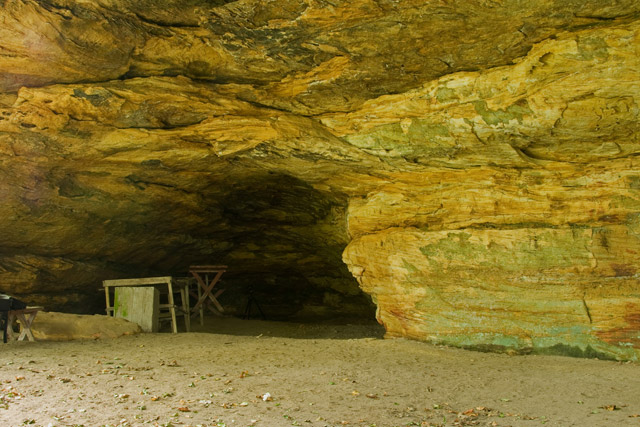 Cave in sandstone overhang, Deep Woods Preserve, Hocking County, Ohio, September 19, 2008. The deepest darkest recess is the habitat of the Applachian gametophyte, Vittaria applachiana. 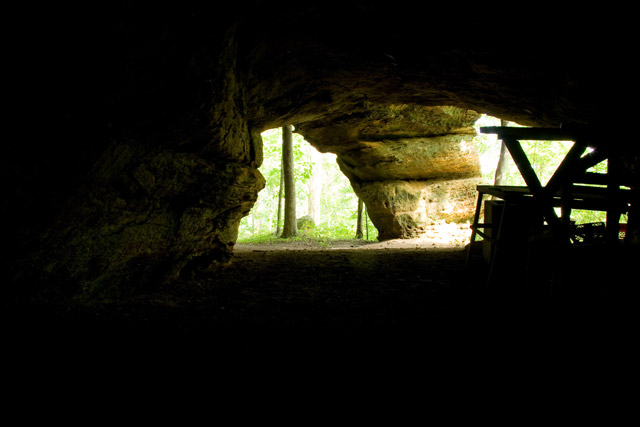 Gametophyte's-eye view of the cave habitat of the Appalachian gametophyte.  Appalachian gametophyte on sandstone cave wall, September 19, 2008, Hocking County, Ohio.  Appalachian gametophyte with fingerlike asexual gemmae, September 19, 2008, Hocking County, Ohio. |

